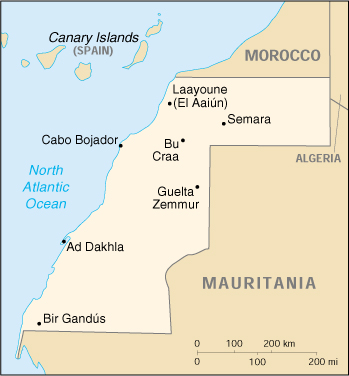Facts About Western Sahara
Background: Morocco virtually annexed the northern two-thirds of Western Sahara (formerly Spanish Sahara) in 1976, and the rest of the territory in 1979, following Mauritania’s withdrawal. A guerrilla war with the Polisario Front contesting Rabat’s sovereignty ended in a 1991 cease-fire; a referendum on final status has been repeatedly postponed and is not expected to occur until at least 2002.
Government type: legal status of territory and question of sovereignty unresolved; territory contested by Morocco and Polisario Front (Popular Front for the Liberation of the Saguia el Hamra and Rio de Oro), which in February 1976 formally proclaimed a government-in-exile of the Sahrawi Arab Democratic Republic (SADR); territory partitioned between Morocco and Mauritania in April 1976, with Morocco acquiring northern two-thirds; Mauritania, under pressure from Polisario guerrillas, abandoned all claims to its portion in August 1979; Morocco moved to occupy that sector shortly thereafter and has since asserted administrative control; the Polisario’s government-in-exile was seated as an OAU member in 1984; guerrilla activities continued sporadically, until a UN-monitored cease-fire was implemented 6 September 1991.
Capital: none
Currency: 1 Moroccan dirham (DH) = 100 centimes
Geography of Western Sahara
Location: Northern Africa, bordering the North Atlantic Ocean, between Mauritania and Morocco
Geographic coordinates: 24 30 N, 13 00 W
Area:
total: 266,000 sq km
land: 266,000 sq km
water: 0 sq km
Land boundaries:
total: 2,046 km
border countries: Algeria 42 km, Mauritania 1,561 km, Morocco 443 km
Coastline: 1,110 km
Maritime claims: contingent upon resolution of sovereignty issue
Climate: hot, dry desert; rain is rare; cold offshore air currents produce fog and heavy dew
Terrain: mostly low, flat desert with large areas of rocky or sandy surfaces rising to small mountains in south and northeast
Elevation extremes:
lowest point: Sebjet Tah -55 m
highest point: unnamed location 463 m
Natural resources: phosphates, iron ore
Land use:
arable land: 0%
permanent crops: 0%
permanent pastures: 19%
forests and woodland: 0%
other: 81%
Natural hazards: hot, dry, dust/sand-laden sirocco wind can occur during winter and spring; widespread harmattan haze exists 60% of time, often severely restricting visibility
Environment – current issues: sparse water and lack of arable land
Environment – international agreements:
party to: none of the selected agreements
signed, but not ratified: none of the selected agreements
Geography – note: the waters off the coast are particularly rich fishing areas
People of Western Sahara
Population: 273,008 (July 2005 est.)
Population growth rate: 2.29%
Birth rate: 45.07 births/1,000 population
Death rate: 16.11 deaths/1,000 population
Net migration rate: -6.05 migrant(s)/1,000 population
Infant mortality rate: 133.59 deaths/1,000 live births
Life expectancy at birth:
total population: 49.81 years
male: 48.65 years
female: 51.33 years
Total fertility rate: 6.64 children born/woman
Nationality:
noun: Sahrawi(s), Sahraoui(s)
adjective: Sahrawian, Sahraouian
Ethnic groups: Arab, Berber
Religions: Muslim
Languages: Hassaniya Arabic, Moroccan Arabic
Western Sahara Economy
Economy – overview: Western Sahara, a territory poor in natural resources and lacking sufficient rainfall, depends on pastoral nomadism, fishing, and phosphate mining as the principal sources of income for the population. Most of the food for the urban population must be imported. All trade and other economic activities are controlled by the Moroccan Government. Incomes and standards of living are substantially below the Moroccan level.
GDP – composition by sector:
services: 40%-45% (1996 est.)
Labor force: 12,000
Labor force – by occupation: animal husbandry and subsistence farming 50%
Industries: phosphate mining, handicrafts
Electricity – production: 85 million kWh (1998)
Electricity – production by source:
fossil fuel: 100%
hydro: 0%
nuclear: 0%
other: 0% (1998)
Electricity – consumption: 79 million kWh (1998)
Agriculture – products: fruits and vegetables (grown in the few oases); camels, sheep, goats (kept by nomads)
Exports – commodities: phosphates 62%
Exports – partners: Morocco claims and administers Western Sahara, so trade partners are included in overall Moroccan accounts
Imports – commodities: fuel for fishing fleet, foodstuffs
Imports – partners: Morocco claims and administers Western Sahara, so trade partners are included in overall Moroccan accounts
Currency: 1 Moroccan dirham (DH) = 100 centimes
Map of Western Sahara
